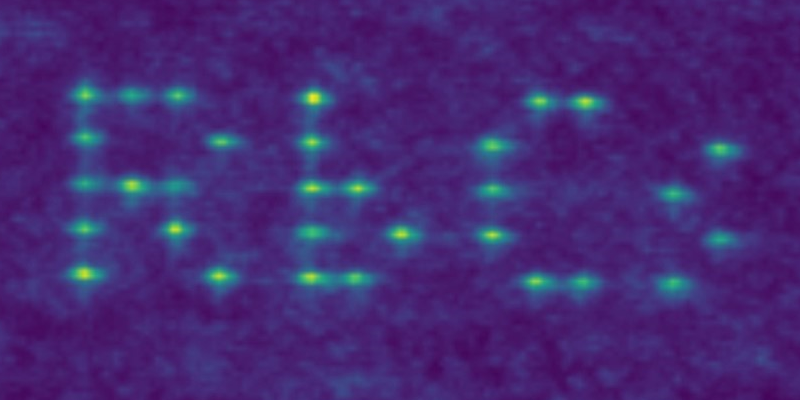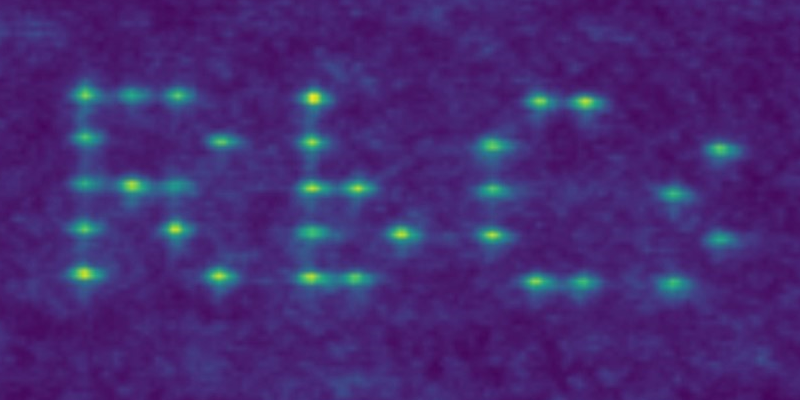Atom and Molecule Form Quantum “Blockade”
To perform quantum computations using the quantum states of atoms, those states need to be entangled, making them interdependent. One way to do that uses an effect called the Rydberg blockade, whereby two atoms are coupled such that only one of them can be in a highly excited (“Rydberg”) state at any moment. Such coupling has now been demonstrated for the pairing of an atom with a molecule [1], a system that offers advantages over using atoms alone. The result opens the way to implementing quantum logic gates using such atom–molecule pairs and to fundamental investigations involving the precision control and measurement of the quantum states of molecules.
In a Rydberg state, an electron is boosted into a very high energy level, orbiting far from the nucleus so that the atom has a much larger size than normal, with a width that approaches a micrometer or so. Atoms can be placed in these states using an excitation laser. However, if two such atoms are close enough to interact through their electric fields, then the Rydberg transition of one atom will shift out of resonance with the excitation laser [2, 3] . As a result of this Rydberg blockade, only one atom can be excited by the laser—but it is not possible to identify which one. This uncertainty means that the two atoms become quantum entangled and can be used as logic gates for quantum information processing [4]—although researchers have yet to perform quantum computing tasks with Rydberg atoms.
The Rydberg blockade can also be induced by interactions with another kind of particle, such as a molecule. If a molecule comes close enough to an atom, the atom’s Rydberg transition can be turned off. The advantage of such a hybrid Rydberg atom–molecule system, says physicist Alexander Guttridge of the University of Durham in the UK, is that there’s more scope for selective and precise control of the two components. “Molecules have vastly different transition wavelengths to atoms” he says, “so it is possible to independently manipulate the two species and read out the atomic state without affecting the molecule.”
For quantum information processing with such a hybrid system, information would be encoded in an excited state of the molecule—say, in a particular rotational state. Two molecules, in effect acting as the quantum bits (qubits), could be entangled by using a single Rydberg atom placed between them [5]. If both molecules are in their ground state (encoding a 0), the intervening atom’s Rydberg transition can be excited. But if either molecule is in the excited state (encoding a 1), the transition is suppressed by the blockade. These molecular states can be long-lived: a key requirement for carrying out complex quantum computations.
The principles of the hybrid scenario are clear enough, but putting them into practice experimentally is another matter. A key challenge is to position a molecule and an atom close enough to activate the blockade—typically a few hundred nanometers—and to be able to manipulate this separation precisely. Guttridge and colleagues have now achieved that by holding the molecule and the atom in separate “optical tweezers” created from laser beams.
The atom was rubidium, while the molecule consisted of two atoms, one of rubidium and one of cesium. The researchers placed the molecule into its ground state using lasers and magnetic fields. They then used the tweezers to position the molecule within 300 nm of the lone rubidium atom. In this position, the electric-field interaction suppressed the Rydberg transition of the rubidium atom, as predicted. The effect vanished when the molecule was moved to a distance of 700 nm.
Guttridge says that, beyond the possibilities for quantum computation, the technique might enable explorations of fundamental physics using molecules. The use of the Rydberg blockade could allow precise measurements of molecular quantum transitions, potentially revealing new phenomena that could be signatures of dark matter or of new theories of high-energy physics [6].
“This is a really exciting development, as it represents the first measurement coupling a Rydberg atom to a polar molecule,” says Jonathan Pritchard, a specialist in quantum optics at the University of Strathclyde in the UK. The work “opens new possibilities in developing hybrid platforms for quantum computation and simulation,” he says.
Before this work, says physicist Stephan Dürr of the Max Planck Institute for Quantum Optics in Germany, it was unclear whether an atom–molecule Rydberg blockade could be observed at all. If the separation of the two is too small, they might collide and lose or gain energy; if it is too large, they might be out of the range of the interaction. “The massively good news of this work is that there is a sweet spot in between,” he says.
–Philip Ball
Philip Ball is a freelance science writer in London. His latest book is How Life Works (Picador, 2024).
References
- A. Guttridge et al., “Observation of Rydberg blockade due to the charge-dipole interaction between an atom and a polar molecule,” Phys. Rev. Lett. 131, 013401 (2023).
- E. Urban et al., “Observation of Rydberg blockade between two atoms,” Nat. Phys. 5 (2009).
- T. Wilk et al., “Entanglement of two individual neutral atoms using Rydberg blockade,” Phys. Rev. Lett. 104, 010502 (2010).
- M. Saffman et al., “Quantum information with Rydberg atoms,” Rev. Mod. Phys. 82 (2010).
- C. Zhang and M.R. Tarbutt, “Quantum computation in a hybrid array of molecules and Rydberg atoms,” PRX Quantum 3 (2022).
- M. S. Safronova et al., “Search for new physics with atoms and molecules,” Rev. Mod. Phys. 90 (2018).






